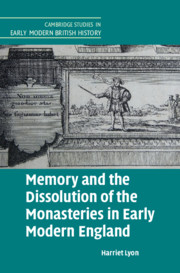Book contents
- Memory and the Dissolution of the Monasteries in Early Modern England
- Cambridge Studies in Early Modern British History
- Memory and the Dissolution of the Monasteries in Early Modern England
- Copyright page
- Dedication
- Contents
- Figures
- Acknowledgements
- Note on the Text
- Abbreviations
- Introduction
- Chapter 1 ‘No News but the Abbeys Shall Be Down’
- Chapter 2 ‘Worthy of Lasting Memory’
- Chapter 3 ‘Raised Out of the Ruins’
- Chapter 4 ‘Many Pretty Odd Tales’
- Conclusion
- Bibliography
- Index
Introduction
Published online by Cambridge University Press: 08 October 2021
- Memory and the Dissolution of the Monasteries in Early Modern England
- Cambridge Studies in Early Modern British History
- Memory and the Dissolution of the Monasteries in Early Modern England
- Copyright page
- Dedication
- Contents
- Figures
- Acknowledgements
- Note on the Text
- Abbreviations
- Introduction
- Chapter 1 ‘No News but the Abbeys Shall Be Down’
- Chapter 2 ‘Worthy of Lasting Memory’
- Chapter 3 ‘Raised Out of the Ruins’
- Chapter 4 ‘Many Pretty Odd Tales’
- Conclusion
- Bibliography
- Index
Summary
England was a different place after the dissolution of the monasteries. Between 1536 and 1540, Henry VIII’s government dissolved more than 800 religious houses and, in doing so, disrupted patterns and rhythms of daily life that had existed for centuries. Since the Early Middle Ages, religious orders had performed vital spiritual services for local communities. They were also major landowners, whose vows of chastity, poverty, and obedience went hand-in-hand with a duty to provide charity and hospitality to the laity. Although monasticism was never officially prohibited by the Henrician regime, the dispersal of the religious orders and the partial destruction of monastic buildings amounted to its de facto abolition. Some 12,000 monks, nuns, and friars were pensioned off and absorbed into secular society, whilst their abbeys, convents, and friaries were stripped of anything of use or value by the government’s agents and, later, by members of the communities that had grown up around the religious houses. In many places, stone skeletons were all that remained of some of the most magnificent structures in medieval England.
- Type
- Chapter
- Information
- Publisher: Cambridge University PressPrint publication year: 2021

